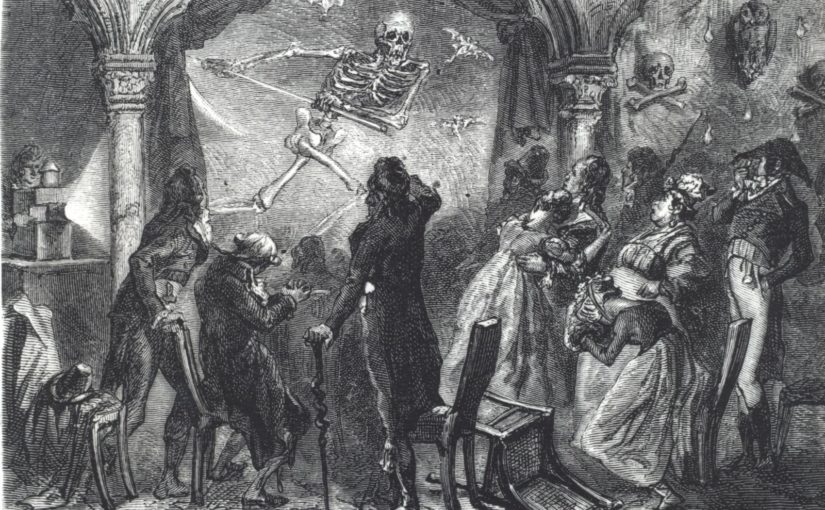The evoking the spirit of the dead was an activity that attracted the interest of people from all social classes in the 18th century, including Freemasons. At that time many of the Masonic lodges in existence were filled with bored aristocrats with a good majority of them in search of distraction and gratification.
Initially the lodges had only apprentices and companions. It was only in 1724 that a higher degree was introduced and it was one that was inspired by the legend of Hiram Habif, which in turn was based on the even older Egyptian myth of Iris and Osiris. Alchemy scholars of the time could not be anything other than enthusiastic that Hiram’s legend had been introduced in the Masonic ritual; death and resurrection related well to the processes of death, decomposition and sublimation which are considered essential passages for the base metal’s transmutation journey into (philosophical) gold.
Twenty years after the foundation of the Grand Lodge of England (24.6.1717) the Chevalier Andre’ Michel Ramsay (1686-1743) , an expatriate Scotsman who lived in Paris and was the Orator of the Lodge “Le Louis d’Argent” , made a famous speech whereby he affirmed that the 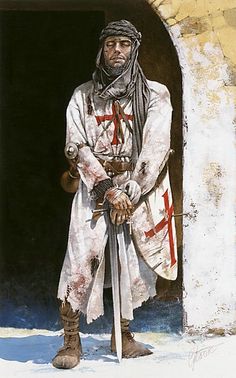 origin of the Masonic Order and of its secret doctrine were aristocratic. He stated that it were the Knights Templar– religious soldiers drawn from the noblest families in Europe – who had rediscovered the secret elements of the Masonic teaching during their stay in the Holy Land (the Orient) and had brought them back to France and Scotland.
origin of the Masonic Order and of its secret doctrine were aristocratic. He stated that it were the Knights Templar– religious soldiers drawn from the noblest families in Europe – who had rediscovered the secret elements of the Masonic teaching during their stay in the Holy Land (the Orient) and had brought them back to France and Scotland.
With such speech Ramsay put the basis for the creation of the Scottish Rite Freemasonry and the acceptance of scholars of Alchemy and of the Occult Sciences into the Masonic Order. Numerous rituals soon began to appear that incorporated this theory and multiple Higher Masonic Orders were established all over Europe each one claiming to be the unique and rightful keeper of the higher secrets. The Ancient and Accepted Scottish rite with its 33 degrees – or levels of knowledge which included of course the three Craft degrees – was the most important but there were many others. For example the Rosicrucian “Orden des Gold und Rosenkreyzes” had a 28th degree which was rich of alchemy contents whereas the “Orde de Elus Coens” – founded in 1760s by Martines de Pasqually (1708-1774) – taught esoterism..
The sophisticated French nobles liked so much the fantastic stories and mysterious tales of the time that from then on they were happy to confuse Alchemy with Chemistry, Astronomy with Astrology and the Magnetism of F.A.Mesmer with Spiritism.
———- ## ———–
The conservatism of the old social order and the strong influence of the Church in continental Europe over everyday people’s life and thinking had pushed Freemasonry into a forced covertness. This peculiar aspect was consequential in transforming the Lodges in places where anti-conformists of all kind met: from the strongest supporters of political freedom and of democracy to the most libertine of individuals.
One such dissolute was, for example, the Duke Philip Warton, chairman of the “Hell Fire Club” and founder in 1724 in Rome – after he was expelled from the GLE – of a Lodge called “Most Ancient and Noble Order of the Gormogons [1]” known for being in total opposition to Freemasonry and famously depicted by Hogarth in his engraving “The Mystery of Masonry”.
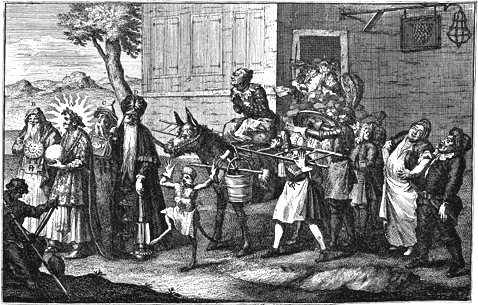
The Italian southern Region of Calabria, part of the Kingdom of Naples and of the Two Sicily, was the residence of the obscure character of the Abbot Geloni and the travel port of the Freemason Count J Ferdinand Kuffstein from Prussia. The latter had been taught by the Abbot, in his Carmelite convent, the secret of how to “create spirits” using the formulae of Paracelsus.
Indeed after spending nine weeks in the Abbot’s laboratory, it is reported that the Count eventually succeeded in creating ten spirits. The miniature creatures or “homunculi were: a king, a queen, an architect, a monk, a miner, a nun, a serafino (child angel), a chevalier or Knight, a blue and a red “spirit”. Kuffstein put them in glass jars filled with potions and took them with him to his Lodge in Vienna; it is said that soon those spirits made some very accurate predictions for Kuffstein and his Brethren. Extraordinary !
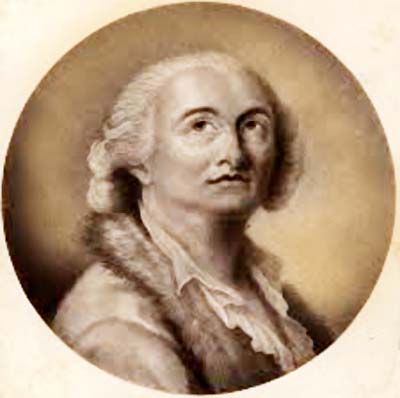
Many hermetists, cabalists and alchemists of the time were also members of the “Illunines d’Avignon”, founded in by the unfrocked Benedictine monk Don Antoine-Joseph Pernety[2] . Of that Order, it is said, was also a member another famous rogue of the century: the self styled Count and Freemason Cagliostro[3]. The Order had six degrees and professed the Alchemy.
Similar examples of Higher Degrees Orders, all claiming to be sole and rightful guardians of a superior knowledge and listing members who dedicated themselves to some quite eccentric and dangerous activities, are numerous in history.
THE CHARLATAN FREEMASON
There are confidence tricksters, quacks and charlatans in every walk of life and Freemasonry was not without a few of its own! The German born Johann Georg Schröpfer was one of the greatest necromancer and imposter of the late 1780s; he was an occultist and a Freemason whose fame has remained alive in history even for the peculiarity of his death!
A member of the Lodge Minerva in Leipzig Schröpfer claimed to be able to raise the spirits of the dead on demand. He clashed a few times with the local Freemason section that followed the strict observance but in the end the Order recognised him as a true Brother.
We are ignorant of the precise year of his birth – 1730 or 1738 – but we know that he had served in a Hussar regiment of the Prussian army, during the seven years war. At the end of the conflict Schröpfer moved to Leipzig where in 1761 he married a local merchant’s daughter. What he did for the ensuing/following few years is unknown but in 1769 he purchased a tavern called the Weisseledersche Kaffeewirtschaft situated right in the centre of town.
At the back of that dwelling he carried out the meetings of his lodge as well as his experiments in necromancy, conjuring up ghostly apparitions with the use of a still largely unknown device.
Schröpfer would begin the evening by serving drinks – probably spiked – to an audience that had been asked to fast for the past 24 hours. Then he would take the participants into the tavern back room which had been adorned with dark drapery and furnished with an altar on which were two human skulls each containing a lit candle so as to provide the right ambience light for the show. The participants would be made to stand inside a magic circle and Schröpfer would burn incense and begin his invocations.
Then the candles would go out and the audience would witness, surrounded by clouds of burning smoke and resounding “ooooh” and “aaahh” exclamations from the more impressionable members of the apparition of ghostly figures who would speak to Schröpfer.
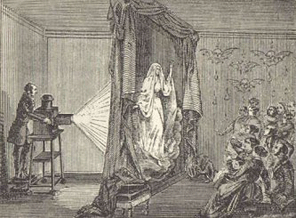
The effects must have looked startling to the naïve !
Then Schröpfer, dressed in a black robe, would threaten the audience not to dare break the circle or face terrible dangers if they did. The whole spectacle was so convincing that fame grew larger and bigger by the day thus securing him the patronage of Prince Karl von Hessen-Kassel who called him to perform a séance for his Court at the Dresden Palace in the Summer of 1774.
THE MAGIC LANTERN
But by the end of the 1780s Schröpfer’ s sessions with the dead began to come under the strict scrutiny of scientifically minded investigators and the unmasking of his tricks came closer by each day that passed.
What Schröpfer and his assisting team were doing consisted in employing a gadget invented a century or so earlier that made appear pictures (faces of ghosts in our case) out of nowhere. That widget was called The Magic Lantern or The Lantern of Fright and it was essentially a projector!
The oldest description of that instrument – in every sense the Cinema predecessor – is dated 1420 when it is mentioned in the “Bellicorum et instrumentorum liber” by Giovanni Da Fontana and it is described as a sort of projector without lenses , that would cast images of the devil on any surface.
In 1659 the Dutch scientist Christiaan Huygens claimed the lantern as his own invention and called it the “Magic Lantern” and in 1678 the Italian optician Don Matteo Campani degli Alimeni (1620-1678) built a prototype from past notes and sketches.
THE DANGER OF EVOKING THE DEAD
Ten years after Schröpfer’s death, the event was thus described by an eye witness – the General Johann Fekete von Galenthe, the Orator of the Lodge of Trieste – to his brother:
(…) “Schröpfer would open the lodge and begin reciting his prayer and incantations. Suddenly the door would spring open and a dense mass of fog would enter and come to a halt in the middle of the room. The fog would then take the shape of a column of smoke which slowly disappeared and the image of an old man or of a young girl would appear and be questioned by Schröpfer, although the interrogator never seemed to receive satisfactory answers. The last time Schröpfer held a séance, instead of the old man or the young pretty girl it was the ghost of a young man with his chin stained with blood that came forward from the other side.
Schröpfer appeared frightened.
The ghost, on being pressed with questions by Schröpfer suddenly raised his finger, interrupted him and in a menacing manner exclaimed: “Scoundrel! Scoundrel! Scoundrel! For you this is the end”. The lodge Tyler reported that a fire inscription had appeared on the door and simultaneously vanished with the phantom the moment the Tyler had posed his hand on it. Schröpfer told his audience that the phantom was an evil force and asked that they should reconvene in Rosenthal the following day, to continue the séance.
When they gathered twenty four hours later, Schröpfer told his followers that he needed to leave the room just for a little while, but very soon the sound of a gunshot was heard and Schröpfer was found in the back room on the floor covered in blood and dead”. His detractors said that he knew he was on the verge of being officially unmasked and that, afraid of facing his downfall, he had decided to commit suicide by shooting himself in the face.
Had Schorpfer been the victim of his own success or had he simply gone insane?
It is not unlikely that he committed suicide for promising more than he could ever in reality deliver and that, as I have said, rather than facing failure and accepting the financial downfall the would follow , he had chosen to take the drastic and cowardly way out of this world. However others claimed that he was being haunted by evil spirits who made him believe he was so powerful as to be able to shoot and resurrect himself.
The eccentricity of Schröpfer’s life and the tragic manner of his death inspired Friedrich Schller’s book “Der Geisterseher” (The Visionary).
But dubbing with the Occult is always considered a dangerous pursuit; those of us who are weak cannot control the adverse powers that may attach to our person and drag us from fatality to fatality! Those influences undermine our mind and body, cause our heart to fail and our brain to haemorrhage. The consequences of contacting the supernatural world are to become infected by it and yet refuse to believe we are impaired by it ; it is to wrongly consider ourselves powerful and able to control malevolent entities and make them come and leave when we wish. In truth we pen the door to evil and we can never close it again till we are dragged to our death.
It is written that to question the Sphinx for fun is a sacrilege that is punished with death.
Wisdom and glory are either obtained through merit or is best not to seek them.
Scire Nefas ! (To know is a sin) said the Roman poet Quintus Horatius Flaccus [4] , more widely known as Horace.
by De La Riviere
The author forbids any reproduction or publication of this article, in full or in part, without his explicit authorisation.
[1] This word in the Oxford English Dictionary means “meaningless”
[2]He signed his name using the Italianised form of Pernetti.
[3] Giuseppe Balsamo from Palermo, Sicily
[4] December 8, 65 BC – November 27, 8 BC
- Influencia de la Masonería en Chile - April 29, 2024
- Pomegranate in Freemasonry – its significance - March 11, 2024
- Inns and Innkeepers’ incidence in Freemasonry expansion - February 28, 2024

